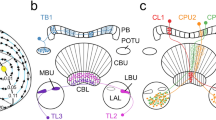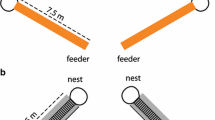Summary
-
1.
The importance of different eye-regions and of different areas within the skylight pattern for the accuracy of polarized light orientation inCataglyphis bicolor has been investigated by restricting the e-vector information in the uv-spectrum to specific parts of the visual field.
-
2.
All parts of the skylight pattern are equally well known to the ants. Looking at areas of maximum or only weak polarization does not influence the orientation performance. The accuracy depends on the position of the visible patch relative to the zero-direction.
-
3.
For e-vector orientation a small quite sharply limited area in the dorsomedial part of the eye appeared to be most important. Its ommatidia are looking at a region of the sky with an elevation ranging from about 43° to 65° to the horizontal plane. The foveal centre lies at approximately 51°.
-
4.
Cinematographically recorded compensatory inclination movements of head and thorax, induced by artificial restrictions of the visible field, lead to angle calculations of 45° for the lower and 60° for the upper margin of the foveal region.
-
5.
The lateral extension of the foveal region could not be defined exactly. The centre, however, is looking at an azimuthal angle of 45° to the head's sagittal plane. The central ommatidia in the foveal region of both eyes include an approximate angle of 90°, thus excluding the interpretation of simultaneous binocular e-vector detection.
-
6.
An aperture with a diameter of 10°, corresponding to a group of 9–17 ommatidia, is sufficient for correct e-vector detection. Polarization analysis is possible with one eye alone.
-
7.
The ommatidia responsible for e-vector orientation have been localized histologically. The behavioural results of the polarization analysis are discussed with regard to neuroanatomical findings in the foveal region.
Similar content being viewed by others
References
Barros-Pita, J. C., Maldonado, H.: A fovea in the praying mantis eye. II. Some morphological characteristics. Z. vergl. Physiol.67, 79–92 (1970)
Batschelet, E.: Statistical methods for the analysis of problems in animal orientation and certain biological rhythms. Amer. Inst. of Biol. Sciences, Washington (1965)
Bauers, Ch.: Der Fixierbereich des Insektenauges. Z. vergl. Physiol.34, 589–605 (1953)
Duelli, P.: The relation of astromenotactic and anemomenotactic orientation mechanisms in desert ants,Cataglyphis bicolor. In: Information Processing in the visual systems of arthropods (R. Wehner, ed.), p. 281–286. Berlin-Heidelberg-New York: Springer 1972
Duelli, P.: Astrotaktisches Heimfindevermögen tragender und getragener Ameisen (Cataglyphis bicolor). Rev. suisse Zool.80, 712–719 (1973)
Duelli, P.: Polarisationsmusterorientierung bei der WüstenameiseCataglyphis bicolor Fabr. (Formicidae, Hymenoptera). Dissertation, Universität Zürich (1974)
Duelli, P., Wehner, R.: The spectral sensitivity of polarized light orientation inCataglyphis bicolor. J. comp. Physiol.86, 37–53 (1973)
Eheim, W. P., Wehner, R.: Die Sehfelder der zentralen Ommatidien in den Appositionsaugen vonApis mellifera undCataglyphis bicolor (Apidae, Formicidae, Hymenoptera). Kybernetik10, 168–179 (1972)
Frisch, K.v.: Tanzsprache und Orientierung der Bienen. Berlin-Heidelberg-New York: Springer 1965
Gemperlein, R.: Grundlagen zur genauen Beschreibung von Komplexaugen. Z. vergl. Physiol.65, 428–444 (1969)
Görner, P.: Beispiele einer Orientierung ohne richtende Außenreize. Fortschr. Zool.21, 20–43 (1973)
Helversen, O.v., Edrich, W.: Der Polarisationsempfänger im Bienenauge: Ein Ultraviolettrezeptor. J. comp. Physiol.94, 33–47 (1974)
Herrling, P. L.: Measurements on the arrangement of ommatidial structures in the retina ofCataglyphis bicolor. In: Information processing in the visual systems of arthropods, (R. Wehner, ed.), p 49–54. Berlin-Heidelberg-New York: Springer 1972
Herrling, P. L.: Topographische Untersuchungen zur funktionellen Anatomie der Retina vonCataglyphis bicolor. Dissertation, Universität Zürich (1975)
Kirschfeld, K.: Die notwendige Anzahl von Rezeptoren zur Bestimmung der Richtung des elektrischen Vektors linear polarisierten Lichtes. Z. Naturforsch.27b, 578–579 (1972)
Kirschfeld, K.: Optomotorische Reaktionen der Biene auf bewegte “Polarisations-Muster”. Z. Naturforsch.28c, 329–338 (1973)
Kunze, P.: Der Einfluß der Größe bewegter Felder auf den optokinetischen Augenstielnystagmus der Winkerkrabbe. Ergebn. Biol.26, 55–62 (1963)
Lüdtke, H.: Die Funktion waagrecht liegender Augenteile des Rückenschwimmers und ihr ganzheitliches Verhalten nach Teillackierangen. Z. vergl. Physiol.22, 67–118 (1935)
Menzel, R., Snyder, W. A.: Polarized light detection in the bee,Apis mellifera. J. comp. Physiol.88, 247–270 (1974)
Menzel, R., Wehner, R.: Augenstrukturen bei verschieden großen Arbeiterinnen vonCataglyphis bicolor. Z. vergl. Physiol.68, 446–449 (1970)
Meyer, H. W.: Visuelle Schlüsselreize für die Auslösung der Beutefanghandlung beim BachwasserläuferVelia caprai. Z. vergl. Physiol.72, 260–297 (1971)
Mittelstaedt, H., Mittelstaedt, M. L.: Mechanismen der Orientierung ohne richtende Außenreize. Fortschr. Zool.21, 46–58 (1973)
Wehner, R.: Visual orientation performance of desert ants,Cataglyphis bicolor, towards astromenotactic directions and horizon landmarks. Proc. AIBS Symp. Animal Orientation and Navigation, (S. R. Galler, eds.), p. 421–436. Washington: US Gov. Print. Off. 1972a
Wehner, R.: Pattern modulation and pattern detection in the visual system of Hymenoptera. In: Information Processing in the visual systems of arthropods, (R. Wehner, ed.), p. 183–195. Berlin-Heidelberg-New York: Springer 1972b
Wehner, R.: Space constancy of the visual world in insects. Fortschr. Zool.23, 148–160 (1975)
Wehner, R., Eheim, W., Herrling, P. L.: Die Rastereigenschaften des Komplexauges vonCataglyphis bicolor. Rev. suisse Zool.78, 722–737 (1971)
Weiler, R., Huber, M.: The significance of different eye regions for astromenotactic orientation inCataglyphis bicolor. In: Information Processing in the visual systems of arthropods, (R. Wehner, ed.), p. 287–294. Berlin-Heidelberg-New York: Springer 1972
Zolotov, V., Frantsevich, L.: Orientation of bees by the polarized light of a limited area of the sky. J. comp. Physiol.85, 25–36 (1973)
Author information
Authors and Affiliations
Additional information
This paper belongs to a thesis done with Prof. Dr. R. Wehner, whom I would like to thank for the subject, many valuable discussions, and for reading the manuscript. I thank my colleagues Drs. P. L. Herrling, W. A. Ribi and cand. biol. E. Meyer for help in the anatomical investigations, and R. Sulzer for constructing the apparatus. The work was financially supported by the Karl Hescheler Stiftung and the Fonds National Suisse de la Recherche Scientifique, grant no. 3.315.70 (R. Wehner). Medicamental equipment was kindly offered by the Hoffmann-La Roche & Co. AG, Basel.
Rights and permissions
About this article
Cite this article
Duelli, P. A fovea for e-vector orientation in the eye ofCataglyphis bicolor (Formicidae, Hymenoptera). J. Comp. Physiol. 102, 43–56 (1975). https://doi.org/10.1007/BF00657484
Received:
Issue Date:
DOI: https://doi.org/10.1007/BF00657484




